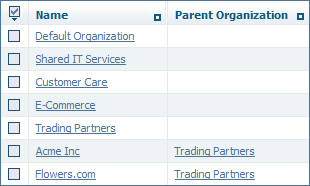Modeling Your Organizations
Although you might want to create an organizational structure that resembles the organization chart within your enterprise, this is not usually a practical strategy. Many low-level organizational units within your enterprise have no relationship to your SOA environment and, therefore, do not need to be represented in the registry. Furthermore, the low-level work groups within an enterprise tend to be very dynamic, which makes them unsuitable entities on which to base your registry's organizational structure.
Instead of organizing the content of your registry around the low-level departments on an organization chart, group it by higher-level concepts such as functional units, lines of business, process owners, legal entities (e.g., subsidiaries and affiliates) or regional divisions. Think in terms of who owns the assets that will reside in the registry or has primary responsibility for developing and maintaining them. Create organizations to represent those areas.
If you intend to give external partners access to CentraSite, create separate organizations for each partner. (By partners we mean any external entities with which your enterprise interacts, such as suppliers and other vendors, dealers and distributors, customers, government agencies, trade organizations and so forth.)
The following shows the organizational structure that is defined in the starter kit example. This example has a level of granularity that is appropriate for defining organizations.
Figure 1. Example Organization Structure
Organization | Description |
Default Organization | This organization serves as the home for administrative and system-wide artifacts. |
Shared IT Services | This organization represents Information Technology (IT) departments that operate across (that is, are shared by) other lines of business. This organization would include the Quality Assurance (QA) department, the SOA Competency Center and individuals who serve as enterprise-wide IT architects. |
Customer Care | This organization serves as the home for administrative and system-wide artifacts. |
E-Commerce | This organization represents the department responsible for providing external-facing services including customer-facing portal sites and business-to-business services. |
Trading Partners | This organization is the parent organization for all external partner organizations. It is a pseudo organization that is used to hold organizations that represent external parties. |
Acme Inc. | This organization represents an external partner that provides or consumes assets. This organization is a child of the Trading Partners organization. |
Flowers.com | This organization represents an external partner that provides or consumes assets. This organization is a child of the Trading Partners organization |
If you are using a multi-stage deployment, you might replicate the same organizational structure across all registries. Or you might adopt a different structure in each registry. For example, on the creation CentraSite you might use the organizational structure like the one described above. However, on the consumption CentraSite, you can define just two organizations: an operations organization, which owns and manages all of the assets in the registry, and a consumer organization, which contains users who can browse the consumption registry. The organizational structure that you adopt for other stages will depend on your requirements.

